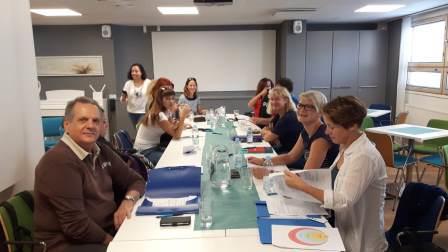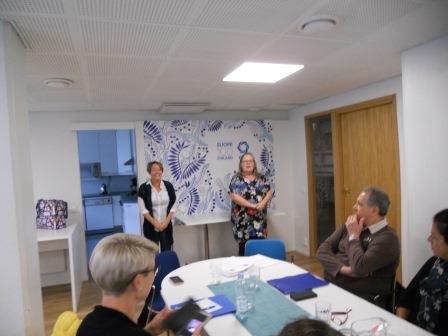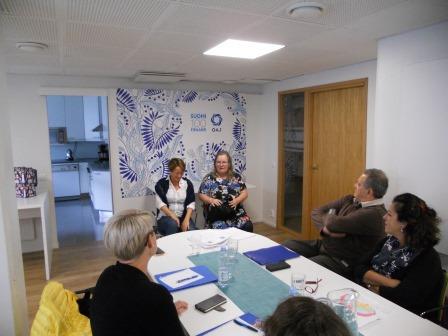3. dan – Utorak, 20. Kolovoza 2019.
Današnji dan je u potpunosti posvećen Fincima.
Počeli smo rasplesano. Kako Finci dozvoljavaju bliži tjelesni kontakt samo u tri socijalne situacije, od kojih je jedna plesanje tanga, počeli smo s njegovim plesnim koracima. Plesali smo još i valcer, finski ples Letkajenkka i, po želji naših sudionica Slovenki, polku.
Znojni, ali opušteni i dobrog raspoloženja u nastavku dana posvetili smo se težoj temi, a to je finski školski sustav. Naša očekivanje bila su, nažalost, sasvim suprotna od onoga što smo čuli.
Organizacijski, razlike između finskog i hrvatskog školskog sustava su u trajanju nastave (ukupno vrijeme za jedan predmet je 60 minuta, od kojeg na školski sat otpada 45 minuta), djeca mlađe školske dobi umjesto drvenih stolaca imaju sofe i jastuke, oni imaju opisne, a ne brojčane ocjene. Plaća učitelja početnika je 2800 eura, a iskusnijeg oko 3500 eura, a kod nas od tek 800 do 950 eura. Nekada učitelji nisu primali plaću ljeti, danas je primaju, kao i regres. Svaki učitelj ima obavezu godišnjeg stručnog usavršavanja i to mu je povezano s visinom plaće.
I u Finskoj se produljilo vrijeme studiranja do učiteljske diplome, a time se, prema Paulinom mišljenju, smanjila kvaliteta izvođenja nastave. Studenti nisu usmjereni na praksu već na mnoge teoretske sadržaje koji su dodani prijašnjem, sabitom programu studija. Sada država više nema dovoljno novaca za nove udžbenike svake godine, pa se oni nasljeđuju, a škole su zamoljene da razredi rade po istim udžbenicima.
Paula nam je detaljno pripovijedala i objašnjavala odrednice finskog kurikuluma, a mi smo redovito odobravali njezine rečenice potvrđujući da je tako i u našim državama. Sličnosti smo pronašli u velikoj učiteljevoj autonomiji, u jednakim prilikama za svu djecu, besplatnom školovanju,nedostatku nacionalnih testova u osnovnoškolskom obrazovanju, učeničkom samovrednovanju. Prema kurikulumu koji ima oko 600 stranica i čiji tekst svatko tumači na svoj način, učitelj više nije učitelj već trener, koordinator. Naglasak je na djetetu koje razvija odgovornost za svoje učenje.

Finski kurikulum, koji je na snazi četiri godine ima mnoge kritičare. Gotovo svakodnevno se pojavljuju novinski članci koji ga kritiziraju. Nažalost, kritike su prisutne i unutar učiteljske populacije, ne vole ga.
Što se tiče dobrih rezultata finske djece na PISA testiranjima, Paula kaže da niti samim učiteljima nije jasno kako ih postižu. Vjeruje da je država, koja je bila u lošem položaju nakon propasti Nokije, morala nešto prodati, a to je bilo obrazovanje. Sada i Finci padaju na ljestvicama PISA testova. Orijentirani su na igrice i njihovu prodaju. Mogući razlog zbog kojih su finska djeca imala dobre rezultate vidi u titlovima na finskom jeziku (umjesto sinkronizacije) i nekadašnjoj zadaći obrazovnih ustanova. U predškolskim ustanovama djeca se nisu spremala za školu vrlo određenim programom kao sada, već su se samo igrala, a sa 7 godina su bila spremna usvajati sadržaje koji su bili pred njima. Isto tako, sada se svaki produkt djeteta smatra „dobrim“, bez obzira kakav rezultat postigao. Dijete se samo hvali jer je to napravilo samostalno. Također, prebrzo je uvedena digitalizacija, stalno se traži nešto novo, a prošlotjedni sadržaji i aktivnosti danas su stari. Djeca su okupirana isključivo igrom, ali ne u cilju poboljšanja socijalnih odnosa, već onim kompjutorskim. Vrlo rijetko studiraju društvene ili humanističke znanosti, samo business, informatiku, management.
Vrlo zanimljivo je bilo čuti i gledati obilježja finske kulture. Finci jako poštuju osobni prostor, tako da, za nas južnjake, njihovo ponašanje prilikom čekanja autobusa, rasporeda sjedenja u njemu gotovo karikaturalno. Otuđeni su jedni od drugih, izbjegavaju bilo kakav kontakt s osobama koje ne poznaju, okreću glavu od njih. Brane se rukom ili čašom u ruci od dodira, rukovanja, a kamoli zagrljaja. Ne koriste MOLIM nego samo nastavak riječi daje dojam pristojnosti obraćanja. Ne koriste titule već samo imena. Koriste se negativnim govorom, na pitanja o sebi odgovaraju indiferentno, negativno. O odgovoru na pitanje razmišljaju dugo. Govore sporo (dijelom zbog tehničke zahtjevnosti jezika). Ne upadaju u riječ, čekaju svoj red. Tišina u komunikaciji, npr. među bračnim partnerima znak je velikog međusobnog povjerenja i razumijevanja. Točni su, dolaze na sastanak prije zakazanog vremena. Obećano uvijek realiziraju. Vjeruju autoritetima, dakle i učiteljima. Poslušno čekaju (pješaci) kad je na semaforu crveno svjetlo, pa i noću kad su ulice prazne. Najveća vjerska skupina su luterijanci. Spadaju u vodeće zemlje što se porasta nasilja tiče, zbog pijanstva.
Dan je završio veselim dramatizacijama pojedinih životnih situacija i ponašanja Finaca u njima.


3rd day – Tuesday, 20th August 2019
Today is completely dedicated to Finnish.
We started off dancy. As Finns allow physical contact in only three social situations, one of them being tango dancing, we started with its dance moves. We also did the waltz, Finnish dance Letkajenkka and as our colleagues from Slovenia wished, polka.
Sweaty, but relaxed and feeling good we moved on with a more difficult topic –Finnish school system. Our expectations were, unfortunately, a complete opposite of what we heard.
There are some differences between Finnish and Croatian school system. In Finland, one lesson is 60 minutes long (45 minutes for active learning and a 15 minute break) while in Croatia breaks are shorter. Younger Finnish children have sofas and pillows and not the wooden chairs like Croatian. School marks are descriptive, not numerical. The salaries for Finnish teachers vary between 2800 and 3500 euros while Croatian teachers get paid from 800 to 950 euros a month. Previously, Finnish teachers didn’t get paid in the summertime, but now they do as well as the regress. Every teacher has the duty of professional development and that’s connected with the salary value.
In Finland, the time of studying to get your teacher’s diploma has prolonged and, in Paula’s opinion, the quality of teaching has decreased. The students are not focused on the practical aspect of teaching but on the theoretical content which was added to the past, too compacted study program. Nowadays, the country can’t found the new textbooks every year so they are inherited from previous generations. The schools are requested to work with the same books.
Paula explained in detail determinants of the Finnish curricula while others confirmed that the same situations are in our countries. The similarities were found in teachers’ big autonomy, the same opportunities for all children, free education, the lack of national exams in primary schools and lack of students’ self-evaluation. According to the curricula which has about 600 pages and whose meaning everyone explains in their own way, the teacher becomes less of a teacher and more of a trainer or a coordinator. The emphasis is on the student who develops the responsibility for his education.
Finnish curricula, which has been valid for 4 years now, has received a lot of criticism. Almost every day the articles appear in the media, criticizing it. Unfortunately, the teacher population is also not a fan of it.
In terms of Finnish students’ good results on PISA tests, Paula claims that even the teachers don’t understand how those good results happen. She believes that the country was in a bad financial situation after the downfall of the Nokia company, so that they had to sell something – education. Now, even they are falling on the PISA testing charts. They are focused on games and their sale. The possible reason the Finnish children had good results is seen in subtitles in Finnish (instead of synchronization) and the former task of educational institutions. In preschool, the kids didn’t get prepared for school in a certain way like nowadays. Instead, they were playing and at the age of 7, they were ready to overcome challenges that were put in front of them. Also, today is everything that a child does considered good, not minding the result. The important thing is that the student did it by himself. Additionally, the digitalization was brought in too fast, something new and innovative is wanted every day and the last week’s contents are considered old. The children are occupied only by games, but not to embrace the social communication but digital. Very rarely students decide to study humanities or social sciences, they would rather pick business, IT or management.
It was interesting to hear about Finnish culture. Finns are very respective about personal space. So, for us from the south, their behaviour while waiting for a bus or taking the seats in it is somewhat a caricature. They are estranged from each other, they avoid any kind of contact with people they don’t know, even turn their head away from them. They defend themselves from physical contact (shaking hands, touch and hugs) using hands, cups and glasses. They don’t ever use the word please but add the suffix to the word to get the impression of polite behaviour. They don’t use titles, just names. They actively use the negative speaking; they answer the questions about themselves indifferently, negatively. Also, it takes a long time to answer the actual question. They talk very slowly (partly due to the technical difficulty of the language). They don’t interrupt when you speak, kindly waiting for their turn. The silence is a sign of huge trust, for example between married couples. They are never late; they would rather come earlier to the meeting. Promised things are always realized. They trust the authorities, as well as the teachers. People wait for the green light even when it’s late night and no car is around. The biggest religious group is consisted of Lutherans. Finland is high on the violence charts because of the drinking.
The day ended up with role playing of Finnish life situations and their specific behaviour.